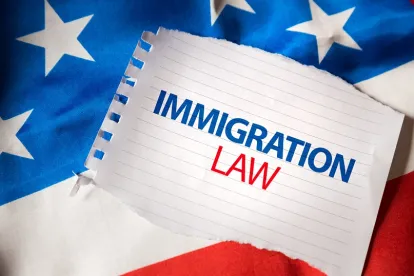On October 8, 2020, the U.S. Department of Homeland Security (DHS) published its long-speculated interim final rule, “Strengthening the H-1B Nonimmigrant Visa Classification Program.” According to the interim final rule’s summary, the purpose of the new rule is to “strengthen the integrity of the H-1B program during the economic crisis caused by the COVID-19 public health emergency to more effectively ensure that the employment of H-1B workers will not have an adverse impact on the wages and working conditions of similarly employed U.S. workers.”
The new rule will become effective on December 7, 2020, 60 days following its publication date in the Federal Register. Generally, DHS would be subject to the standard notice-and-comment rulemaking procedures under the Administrative Procedure Act (APA), which requires a period of public commentary on a rule before its implementation. DHS has justified bypassing regular notice-and-comment rulemaking by arguing that such procedures would defeat the purpose of the rule, which is to provide immediate protection to U.S. workers amid the coronavirus pandemic.
Below is a summary of the most notable changes to the H-1B visa program included in the DHS interim final rule.
The Definition of “Specialty Occupation”
What’s new?
The new rule amends the definition of a “specialty occupation” to clarify that there must be a direct relationship between the required degree fields and the duties of the position. The rule further clarifies that a position would not qualify as a specialty occupation if the position required only a general degree (such as a degree in business administration) without further specialization (such as a more narrow specialization in business analytics).
What’s changed?
The prior regulatory definition of “specialty occupation” did not specifically require that there be a direct relationship between the proffered position and the duties of the position, nor did it require that a general degree have a further specialization. Rather, the prior definition simply stated that a “specialty occupation” was one which “require[d] the attainment of a bachelor’s degree or higher in a specific specialty, or its equivalent, as a minimum for entry into the occupation in the United States.”
What’s the impact?
These changes largely codify the administration’s current policies with respect to H-1B adjudications. The changes track much of the language and tenor that have been in use by U.S. Citizenship and Immigration Services (USCIS) and often seen in requests for evidence challenging a beneficiary’s educational background or the acceptable fields of study for the proffered position.
The Regulatory Criteria for “Specialty Occupation” Positions
What’s new?
The new rule amends the regulatory criteria for specialty occupation positions to clarify that it is no longer sufficient for employers to show that a degree is “normally,” “commonly,” or “usually” required in order to meet the burden of proof in establishing that a position is a specialty occupation. Rather, the new rule now requires that employers show that a degree is “always” required in order to qualify under the new regulatory definition of “specialty occupation.”
Accordingly, under the new rule, a petitioner must establish that a bachelor’s degree in a specific specialty or its equivalent is a minimum requirement for entry into the occupation in the United States by showing that this is always the requirement for the occupation as a whole; always the occupational requirement within the relevant industry; always the petitioner’s particularized requirement; or because the position is always so specialized, complex, or unique that it is necessarily required to perform the duties of the specific position.
The new rule also changes the language that precedes the regulatory criteria, replacing the phrase, “[t]o qualify as a specialty occupation,” with the phrase, “[a] proffered position does not meet the definition of specialty occupation unless it also satisfies ….”
What’s changed?
The prior regulatory standard for establishing a specialty occupation stated the following:
To qualify as a specialty occupation, the position must meet one of the following criteria:
-
A baccalaureate or higher degree or its equivalent is normally the minimum requirement for entry into the particular position;
-
The degree requirement is common to the industry in parallel positions among similar organizations or, in the alternative, an employer may show that its particular position is so complex or unique that it can be performed only by an individual with a degree;
-
The employer normally requires a degree or its equivalent for the position; or
-
The nature of the specific duties are so specialized and complex that knowledge required to perform the duties is usually associated with the attainment of a baccalaureate or higher degree.
(Emphasis added.)
What’s the impact?
By replacing the terms “normally,” “commonly,” or “usually” with the term “always,” DHS has dramatically narrowed the definition of what roles may qualify as specialty occupations. According to the interim final rule, employers can no longer show that, in most cases, a bachelor’s degree or the equivalent is required for the role. Under the new rule, the standard has become that a bachelor’s degree is required in all occasions and without exceptions.
Further, by changing the phrasing that precedes the regulatory criteria, the new rule makes it clear that even if an employer makes a showing under one of the four qualifying criteria, it may not be enough for approval of a petition. DHS specifically states in the final rule that this change clarifies that “meeting one of the regulatory criteria is a necessary part of—but not necessarily sufficient for—demonstrating that a position qualifies as a specialty occupation.”
New Regulatory Definitions for “Worksite” and “Third-Party Worksite”
What’s new?
The new rule defines “worksite” as “the physical location where the work is actually performed by the H-1B nonimmigrant.” The new rule defines “third-party worksite” as “a worksite, other than the [H-1B] beneficiary’s residence in the United States, that is not owned or leased, and not operated, by the petitioner.”
What’s changed?
The prior rule did not include specific definitions for “worksite” or “third-party worksite.”
What’s the impact?
The addition of these regulatory definitions helps to clarify the meaning of these terms, which are used extensively in the new rule, especially in sections that deal with third-party placements and site visits, as explained below.
Third-Party Placement Scenarios
What’s new?
The new rule addresses adjudication issues with respect to third-party placement scenarios by making the following changes with respect to the definition of “United States employer”:
-
the new rule replaces the word “contractor” with the word “company” in the existing definition of “United States employer” in order to avoid the erroneous interpretation that a contractor would generally qualify;
-
elaborates upon the requirements for engaging an H-1B beneficiary to work in the United States by clarifying that a petitioner must establish nonspeculative employment for the beneficiary at the time of filing (i.e., there is a bona fide job offer and actual work available as of the requested start date); and
-
elaborates upon the requirements for establishing if a qualifying “employer-employee relationship” will exist between the petitioner and the H-1B beneficiary.
With respect to its elaboration on the requirements for establishing an “employer-employee relationship” for H-1B purposes, the new rule also includes the following list of nonexhaustive factors to be considered by USCIS in a totality-of-circumstances analysis:
-
[w]hether the petitioner supervises the beneficiary and, if so, where such supervision takes place;
-
[w]here the supervision is not at the petitioner’s worksite, how the petitioner maintains such supervision;
-
[w]hether the petitioner has the right to control the work of the beneficiary on a day-to-day basis and to assign projects;
-
[w]hether the petitioner provides the tools or instrumentalities needed for the beneficiary to perform the duties of employment;
-
[w]hether the petitioner hires, pays, and has the ability to fire the beneficiary;
-
[w]hether the petitioner evaluates the work-product of the beneficiary;
-
[w]hether the petitioner claims the beneficiary as an employee for tax purposes;
-
[w]hether the petitioner provides the beneficiary any type of employee benefits;
-
[w]hether the beneficiary uses proprietary information of the petitioner in order to perform the duties of employment;
-
[w]hether the beneficiary produces an end-product that is directly linked to the petitioner’s line of business; and
-
[w]hether the petitioner has the ability to control the manner and means in which the work product of the beneficiary is accomplished.
The new rule also clarifies the types of corroborating evidence petitioners must submit in third-party placement cases in order to establish that the proffered position is a specialty occupation. Such evidence may include copies of “contracts, work orders, or other similar evidence (such as a detailed letter from an authorized official at the third-party worksite) to establish that the beneficiary will perform services in a specialty occupation at the third-party worksite(s), and that the petitioner will have an employer-employee relationship with the beneficiary.”
What’s changed?
The prior regulation defined “United States employer” using the phrase “as indicated by the fact that it may hire, pay, fire, supervise, or otherwise control the work of any such employee.” The new rule strikes this phrase completely and replaces it with a separate definition of “employer-employee relationship” based on common law doctrine. The new rule’s definition of employer-employee relationship now includes the aforementioned nonexclusive list of factors that USCIS can consider as evidence of the relationship. It further clarifies that USCIS will assess and weigh all relevant aspects of the relationship in a totality-of-the-circumstances analysis, and that no one factor is decisive.
What’s the impact?
Third-party placements (i.e., where an H-1B beneficiary works at a facility, other than his/her home, which is not owned, leased, or operated by the petitioner) have long been a focus of H-1B policy. Until recently, USCIS adjudicated third-party placement cases in accordance with guidance in the 2010 USCIS Policy Memorandum, “Determining Employer-Employee Relationship for Adjudication of H-1B Petitions, Including Third-Party Site Placements,” commonly referred to as the “Neufeld Memo.” The interpretations of the employer-employee relationship requirement contained within the Neufeld Memo were recently overturned when a federal judge found them to be inconsistent with existing regulations and would have required traditional notice and comment rulemaking procedures. The new H-1B rule seeks to codify and clarify through rulemaking processes the long-standing employer-employee relationship interpretation and requirements that were introduced in the Neufeld Memo.
Maximum H-1B Validity Period for Third-Party Placements
What’s new?
The new rule sets a one-year maximum validity period for all H-1B petitions in which the beneficiary will be working at a third-party worksite.
What’s changed?
The prior rule allowed third-party placement petitions to be approved in increments of up to three years. In practice, however, USCIS had regularly shortened the validity period of approved third-party placement petitions to align with the duration of the contract or statement of work that governed the placement.
What’s the impact?
Under the new rule, employers will no longer be allowed to request a three-year validity for H-1B petitions where the beneficiary will be employed at a third-party worksite. This will necessitate that such employers file H-1B extensions each year, as opposed to every three years, which in turn will increase the burden and cost of employing H-1B beneficiaries at third-party worksites.
DHS Site Visits
What’s new?
The new rule formally authorizes DHS to perform H-1B site inspections and addresses the consequences of a petitioner’s or a third party’s refusal or failure to cooperate fully with these inspections. The new rule clarifies that inspections may include, but are not limited to, the following:
-
an onsite visit of the petitioning organization’s headquarters, satellite locations, or the location where the beneficiary works or will work, including third-party worksites;
-
interviews with its officials;
-
review of its records related to compliance with immigration laws and regulations; and
-
interviews with any other individuals or review of any other records that USCIS may lawfully obtain and that it considers pertinent to verify facts related to the adjudication of the H-1B petition, such as facts relating to the petitioner’s and beneficiary’s H-1B eligibility and compliance.
The new rule further grants USCIS the authority to deny or revoke an H-1B petition where it is unable to verify the facts related to that petition, or compliance with H-1B requirements, “due to the failure or refusal of the petitioner or a third-party to cooperate with a site visit.”
What’s changed and what’s the impact?
The new rule has formalized DHS’s existing policies and procedures with respect to site visits. DHS has conducted these site visits for some time now for the purposes of ensuring post-filing compliance with H-1B program requirements. The new rule clearly establishes the agency’s authority to perform these onsite inspections, as well as the potential consequences of noncompliance with H-1B program requirements or refusals to cooperate with inspecting officers. The rule also makes it clear that DHS is authorized to conduct site visits at third-party worksites, if applicable, and that third-party worksite employers are expected to cooperate with the inspecting officers.





 />i
/>i

